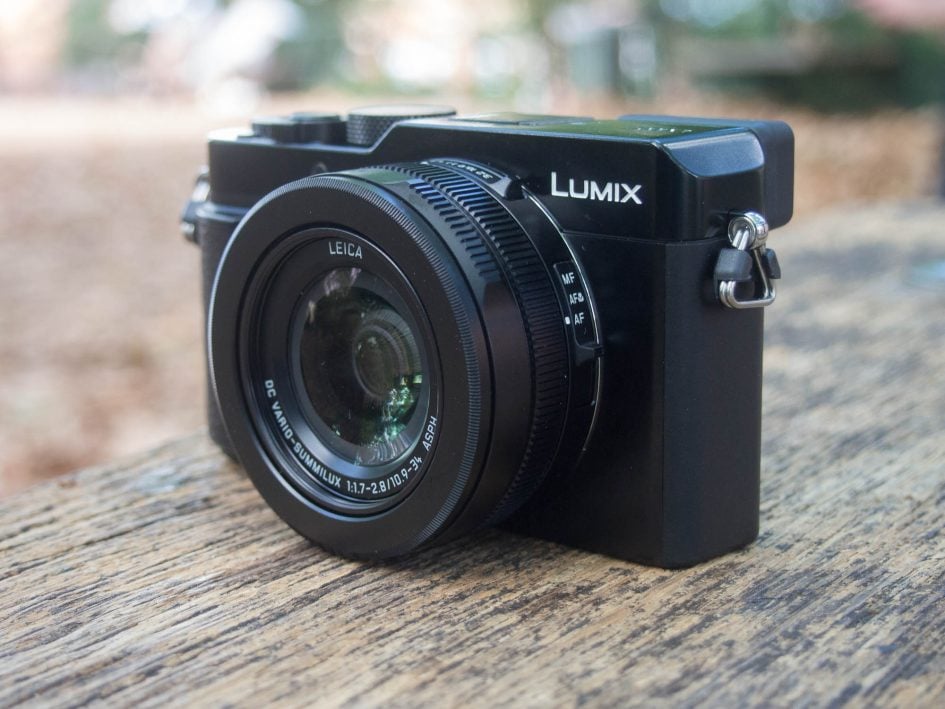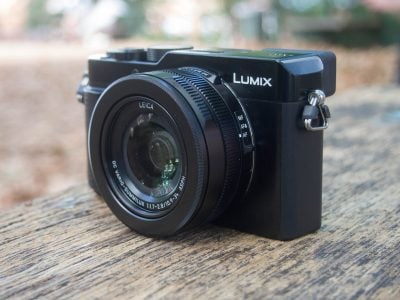Panasonic Lumix LX100 II review
-
-
Written by Ken McMahon
Verdict
The Panasonic Lumix LX100 II is a high-end compact aimed at enthusiasts. It inherits the controls, viewfinder, multi-aspect ratios and 24-75mm f1.7-2.8 lens of the original Mark I but upgrades the resolution, adds a touchscreen, Bluetooth and the latest 4K Photo modes, monochrome picture styles and USB charging. While the screen is now touch-sensitive, it remains fixed in place which will frustrate vloggers as well as those shooting at high or low angles. There’s still no built-in ND filter and it lacks a popup flash, though a small accessory flash which fits in the hotshoe is included in the box.

The field-sequential viewfinder technology delivers an image that isn’t as stable as an OLED panel to my eyes, and it’s worth remembering that while the LX100 II does have a Four Thirds sensor that’s larger than 1in-type sensors in rivals, the lens design means it won’t exploit the full area. The lens range also remains unchanged from the original, it can’t help feeling short compared to rivals like Sony’s (admittedly more expensive) RX100 VI, but it is comparable with competing premium compacts like the Sony RX100 VA and Canon PowerShot G1X Mark III. What’s more the aperture is bright, it can focus very close and the rendering of blurred areas remains the best of its rivals.
Speaking of which, if you’re considering the Lumix LX100 II, you might also want to think about the Canon PowerShot G1X Mark III and the Sony RX100 VA – two models with broadly similar pricing and comparable features but also some fundamental differences. Let’s look first at the Sony RX100 VA, which is a mild update to the 2016 RX100 V.
The RX100 VA is smaller and lighter than the Lumix LX100 II and it also has a smaller 1 inch sensor albeit with a higher 20 Megapixel effective resolution. Its lens has a similar 3x zoom range and is equally bright, or as close as makes little practical difference. It has a 3in screen that tilts vertically down by around 45 degrees or up by 180 degrees to face the subject – very handy for selfies or vlogging and a plus over the fixed screen on the Lumix LX100 II. But the Lumix screen is touch sensitive and the Sony’s isn’t, so you need to decide which of those two screen features is more important to you. As well as the articulated screen, the RX100 VA is equipped with a popup 2.3 million dot OLED viewfinder, lower resolution but more stable than the Lumix LX100 II’s field-sequential electronic viewfinder – again to my eyes.
Both of these models are highly capable video cameras offering 4k UHD shooting as well as a wealth of 1080p video modes. The Sony can record 4k with a minor 1.1x crop but is limited to clip lengths of just five minutes and in my tests overheated after two or three of them in a row. In contrast, the LX100 II applies a tighter 1.25x crop to 4k, but can film clips three times longer – lasting 15 minutes each – and in my tests it managed just over six of them in a row on a single charge without over-heating. Tighter crop-aside, this makes the LX100 II sound more practical, but the contrast-based autofocus isn’t as confident or responsive as the Sony’s phase-detect AF, nor does it have a built-in ND filter or an articulated screen, all of which are very useful for video. The Sony RX100 VA also offers a wealth of high speed, or HFR recording modes, but what the Lumix LX100 II lacks in slomo movie modes it makes up for with its innovative, effective and fun 4k photo modes including 30fps burst shooting, post focus, focus stacking and compositing. Only you can decide which features are more important to you.
Of course in terms of continuous shooting the RX100 VA is no slouch; with 10fps and 24fps with the mechanical and electronic shutter respectively, both with continuous AF and exposure. The RX100 VA also has a more confident phase detect AF system than the contrast detect AF on the LX100 II.
The RX100 VA is currently selling at or below the price of the Lumix LX100 II, so if its smaller size, articulated screen, OLED viewfinder, ND filter, HFR movie modes and advanced AF rank higher in your calculations than the Lumix LX100 II’s slightly larger sensor, touch screen, 4k photo modes, multiple aspect ratios, closer focusing and wealth of physical controls, it could be the better choice. See my Sony RX100 V review for more details.
If you can stretch your budget a little, the Canon PowerShot G1X Mark III is also worth a serious look. The G1X III has a larger 24 Megapixel APSC sensor that will deliver images and video with a higher dynamic range though my tests revealed that in terms of resolving power and noise performance there was little to choose between the G1X Mark III and the LX100 II.
The other big difference between these models is the lens. The zoom range is similar, but the Lumix LX100 II’s f1.7-2.8 lens is more than a stop brighter at the wide angle end of the zoom range and two stops brighter at the telephoto end than the PowerShot G1X Mark III’s f2.8-5.6 lens. While this doesn’t make a huge difference in terms of its ability to blur backgrounds, under the same lighting conditions you’d find yourself having to select 800 ISO on the G1X Mark III compared with 200 ISO on the LX100 II – and that counteracts some of the benefits of having a bigger sensor.
Like the Sony RX100 VA, the PowerShot G1X Mark III is equipped with an articulated screen that can face forwards for selfies and vlogging. The difference is the G1X Mark III’s screen is also touch-sensitive, so you don’t have to choose, you get the best of both worlds. It also has a 2.3 million dot OLED viewfinder, Dual-pixel CMOS AF for confident refocusing, and a built-in 3-stop ND filter, all built into a drip and dust-proof body.
In the cons column, the G1X Mark III’s continuous shooting isn’t as good and it has nothing to compare with the Lumix LX100 II’s 4k photo modes – indeed it doesn’t offer 4k video at all and the lens isn’t nearly as bright, especially at the long-end. As usual paying out a little extra buys you some significant advantages, but there are compromises to be made too. See my Canon PowerShot G1X Mark III review for more details.
Panasonic Lumix LX100 II final verdict
The Panasonic Lumix LX100 II is a high-end compact aimed at enthusiasts. It inherits the controls, viewfinder, multi-aspect ratios and 24-75mm f1.7-2.8 lens of the original Mark I but upgrades the resolution to 17 Megapixels, adds a touchscreen, Bluetooth for easy wireless control, USB charging, and Panasonic’s latest 4K Photo modes and monochrome photo styles. While the screen is now touch-sensitive, it remains fixed in place which makes it less practical for shooting at high or low angles or vlogging compared to rivals like the Sony RX100 VA and Canon G1X Mark III, both of which have articulated screens (albeit not touch-sensitive on the Sony). The Canon and Sony also offer phase-detect autofocus systems which proved more confident for subjects in motion, as well as built-in ND filters and OLED viewfinders – the latter to my eyes, delivering a more stable image than the LX100 II’s field-sequential viewfinder panel. It’s also worth remembering that while the LX100 II does have a Four Thirds sensor, the lens won’t exploit the full area – so while the active area still remains larger than a 1in sensor, it’s not by as much as you might think and makes little difference in practice beyond the ability to choose different aspect ratios without cropping. The 4k video quality is good, and while it incurs a tighter crop than the Sony RX100 VA, it can record clips three times longer and is less susceptible to overheating. The lens, now claiming better resistance against dust, is also comparable in range with the RX100 VA and G1X III, but focuses much closer and boasts superior rendering too, making it the preferred choice for macro shooters. Indeed the optics remain a highlight as does the chance to capture multiple aspect ratios without the usual cropping. It’s also testament to the original design with its wealth of physical controls that the Mark II remains a very enjoyable camera to shoot with, so while it only represents a mild update, it remains a welcome one to bring the feature-set of this attractive compact up-to-date. If however you’re mostly interested in the lens and controls, consider the original LX100 Mark I which can be snapped-up for almost half the price.
Check prices on the Panasonic Lumix LX100 II at Amazon, B&H, Adorama, or Wex. Alternatively get yourself a copy of my In Camera book or treat me to a coffee! Thanks!



